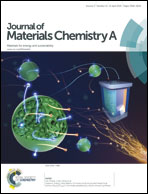2D covalent triazine framework: a new class of organic photocatalyst for water splitting
Abstract
Since the graphene boom, great efforts have been devoted to two-dimensional (2D) monolayer materials with exciting possibilities for applications. Most known 2D materials are inorganic. Using the covalent triazine framework (CTF) as a representative, we explored 2D organic semiconductors using first-principles calculations. From a systematic study of the electronic band structures, work functions, CBM/VBM positions, and optical absorption spectra, we identified the CTF as a new class of 2D visible-light-driven organocatalyst for water splitting. Controllable construction of such CTFs from suitable organic subunits paves the way to correlate band alignment and chemical composites. In addition, multilayer CTFs have enhanced visible-light absorption compared to monolayer CTFs due to interlayer coupling. Our theoretical prediction not only has fulfilled the search for organic counterparts of inorganic photocatalysts for water splitting, but also would motivate scientists to further search for novel 2D organic materials with other technological applications.


 Please wait while we load your content...
Please wait while we load your content...